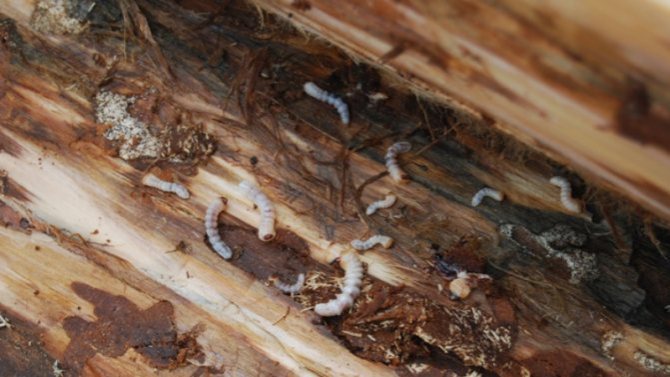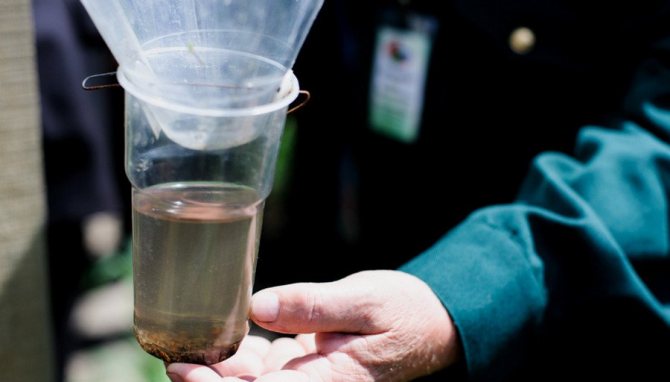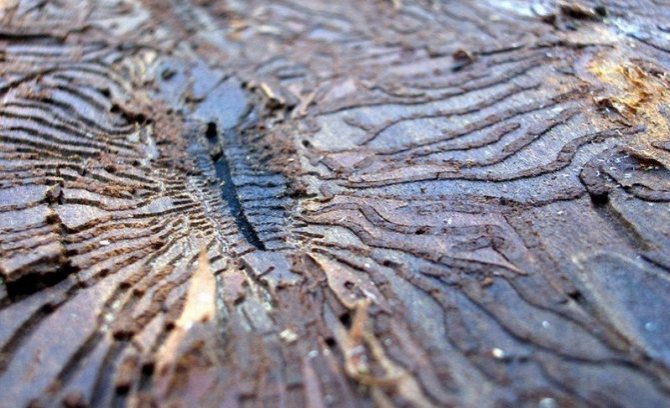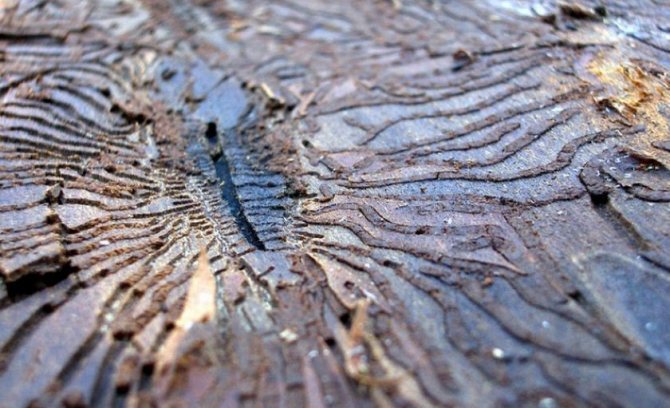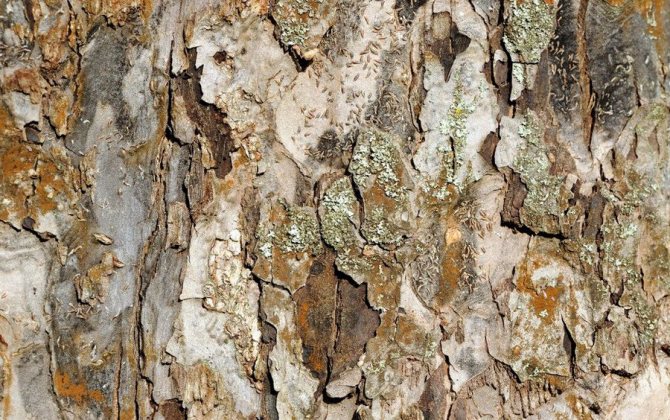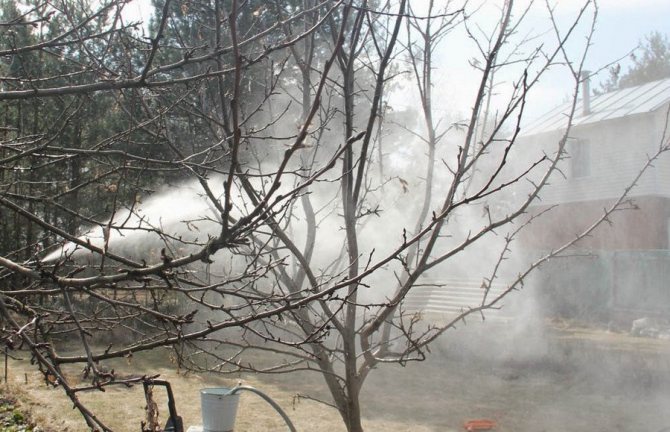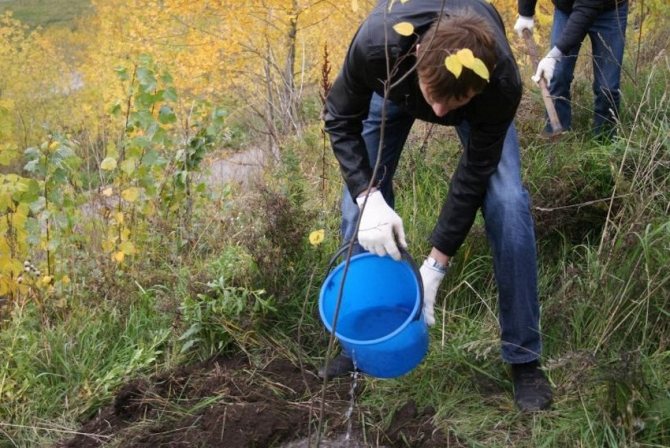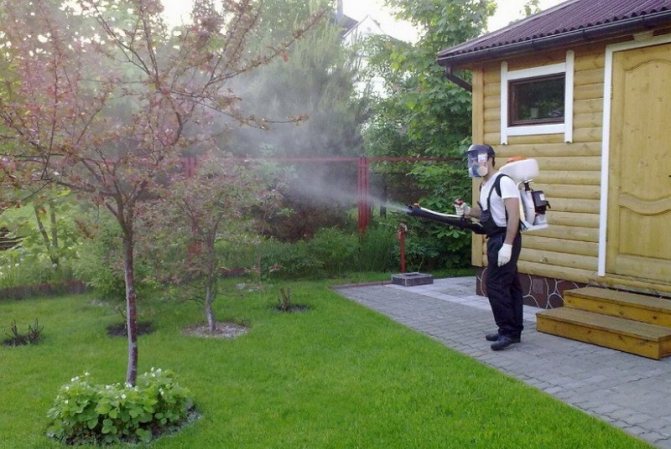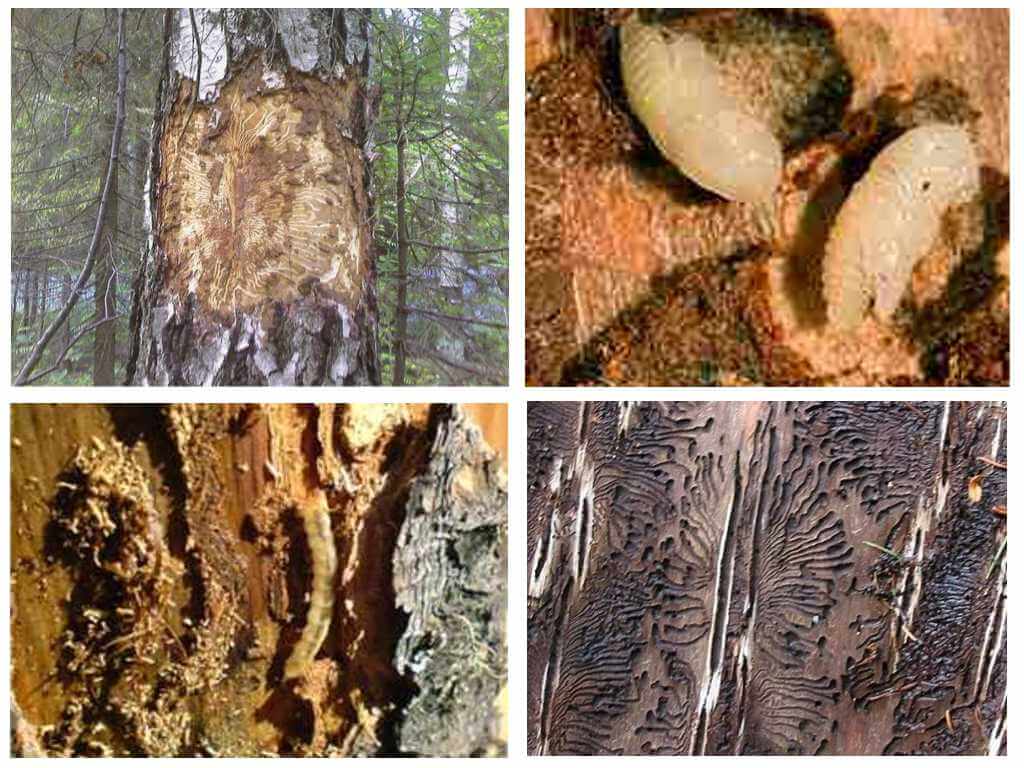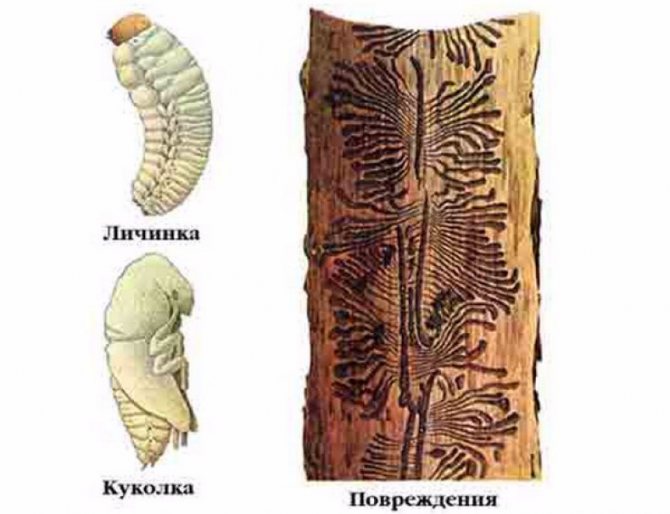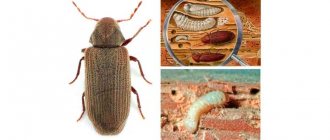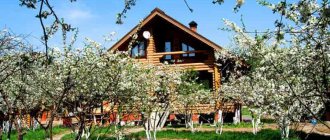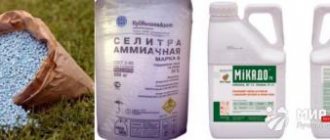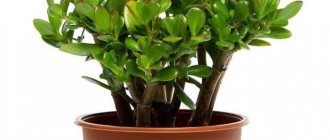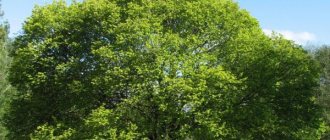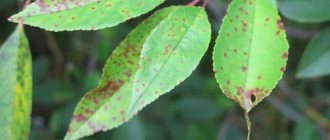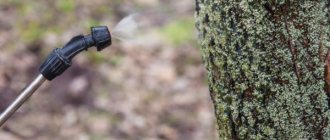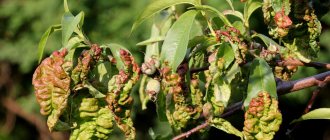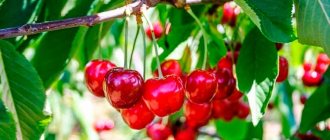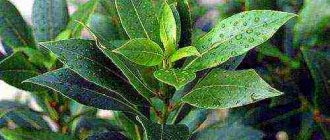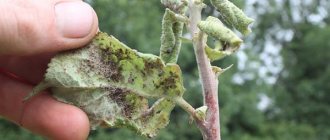»Gardening» Apple tree »How to deal with a bark beetle on an apple tree - advice from gardeners
0
169
Article rating
Fruit trees are often attacked by pests, resulting in less harvest for gardeners, and plants often dying. So, the bark beetle on an apple tree often becomes the reason for its loss, and in the absence of timely measures, the brown sapwood beetle with a striped chitinous shell can destroy the entire orchard.
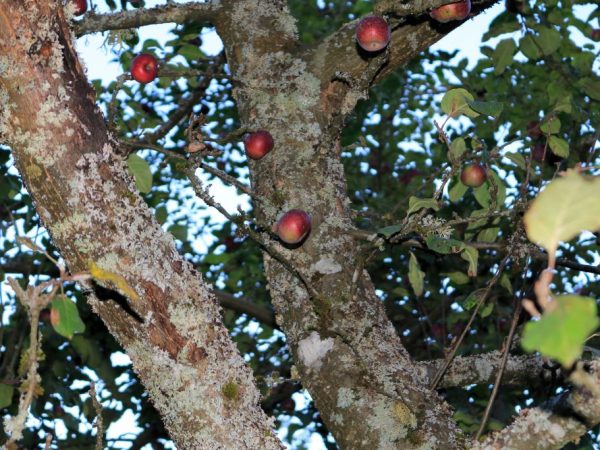
How to deal with a bark beetle on an apple tree - tips from gardeners
Characteristics of the apple bark beetle
The bark beetle, or fruit sapwood, is an insect about 4 millimeters in size. The body of the beetle is cylindrical, dark brown in color. The elytra are covered with punctate grooves and stiff hairs. The tarsi and antennae are dark brown.
The bark beetle spends most of its life in the thickness of the wood, which makes the pest difficult to detect. The insects fly out in the spring, towards the end of the flowering of apple trees. At this time, the beetles mate and settle in new places, infecting fruit trees. The female bark beetle lays eggs under the bark of an apple or pear tree, gnawing passages for numerous egg-laying.
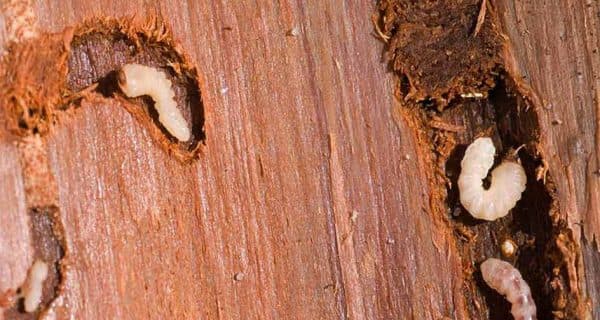

Together with this, the female bark beetle brings in the mycelium of the fungus Monilia Candida, which also begins to occupy the tree.
Whitish larvae with powerful mandibles soon hatch from the eggs. They feed on the tissues and sap of the tree, leaving branched passages in the thickness of the wood. In the spring of next year, the larvae pupate, during the flowering of apple trees they turn into sexually mature beetles and fly out.
Sick, weakened, shaded trees often become victims of the pest. Both adults and young plantings suffer. Such pests as bark beetle, moth, flower beetle and aphids can settle not only on apple trees and pears, but also on stone fruits - cherries, cherries, plums.
Reasons for resettlement
The sapwood beetle attracts the scent of fresh wood to the apple tree. He aspires to those places where recently cut branches are collected, and cuts that have not yet healed are preserved on the tree.
Therefore, one of the reasons is the untimely harvesting of plant residues after pruning in conjunction with a violation of the general rules for processing sections.
Weakened trees with reduced immunity are at risk. In such conditions, the lack of proper feeding or non-compliance with the timing of fertilization is another reason why a bark beetle appears in the apple orchard.
Plants that are not resistant to pests have a thin and weak bark, which insects can easily gnaw.
Signs of defeat
The first signs of bark beetle damage are the appearance of wood flour, sawdust on the bark of a tree or near the trunk. The sawdust is pushed out by beetles and their larvae, gnawing the wood of the fruit tree. When examining the bark, you can notice small holes from where the dust spills out.
The color of the sawdust indicates the degree of damage to the tree:
- brown and brown sawdust show that the bark beetle gnaws bast - the outer shells of the trunk;
- white sawdust - an indicator of deep damage to the trunk by the pest.
Concomitant signs of damage:
- Frequent woodpecker visits to trees. This bird usually feeds on pests that live inside the wood.
- Sudden drying of branches, wilting, stop of shoots in growth.
- The holes in the bark are about 2 millimeters in size, gum flow are obvious symptoms of the activity of the bark beetle.
- Peeling of bark, exposure of wood, eaten away by winding passages - the last stage, which usually ends with the death of the tree.
Experienced gardeners believe that a tree heavily affected by bark beetles does not make sense to treat it - it must be immediately destroyed.
What is the danger
The settlement of the sapwood is a danger to the fruit crop, because parasite infestation and the laying of egg-laying by females leads to:
- malnutrition and metabolic processes;
- creating obstacles to the circulation of plant sap in the form of passages gnawed in woody tissues;
- entry and active spread of infectious diseases.
All these consequences of damage by a pest in the absence of treatment end in the complete death of the tree.
Treatment
Before you start fighting the bark beetle, you need to carefully consider the trees in the garden. If the trunks are worn out by holes from which white sawdust is poured, the bark separates from the wood, there are many winding passages under it - you will have to say goodbye to the tree: cut it down and burn it. This link will tell you what to do if mice gnawed on the bark of an apple tree.
If the holes in the bark are single and the wood flour is brown (the infection is shallow), you can still try to save the tree.
Spraying
A common practice of combating bark beetles is spraying trees after the end of flowering of trees - during the flight of insects. To carry out the procedure, you must have:
- voluminous, reliable sprayer (sprayers with a telescopic boom are convenient);
- overalls, gloves;
- respirator to protect the respiratory tract from poisons (preferably gas and dust models);
- mask or goggles.
The working solution of the drug is abundantly applied to the trunks and branches of apple, pear and other trees. Repeated insecticide treatment is performed after two weeks.
Remember the safety precautions when processing the garden! Use the drugs only in the dosage recommended according to the instructions.
Insecticides
The drugs used to protect trees are systemic insecticides that can accumulate in plant tissues:
Arrivo. The advantages of the drug are high efficiency, duration of action. The disadvantage is the toxicity of the solution for pollinating insects and humans.
"Bitoxibacillin". Effective against adults and larvae, but does not affect eggs. The drug requires repeated treatments. Safe for bees and humans, does not accumulate in fruits.
"Calypso". A fast-acting drug that produces a noticeable effect within a few hours. The action of the agent is prolonged. The disadvantage is toxicity.
"Confidor Extra". Extended-release agent, resistant to high temperatures and rinsing. Effective against pests at any stage. It is not very toxic for humans and animals (III hazard class), however, it is toxic for beneficial microorganisms (do not allow it to enter the soil). "Confidor Extra" is also used for trunk injections into the tree.
BI-58. An organophosphorus preparation that acts in the intestines of the bark beetle. Low hazardous to humans (III hazard class). The disadvantage is that the drug is toxic to bees.
Traps and scarers
A common method of protecting a garden is bark beetle traps and baits. In the spring, branches sawn down during pruning are laid out in piles away from the trees. Beetles are attracted by the smell of sawn wood, they flock to the bait to lay eggs. After the end of the summer of the beetles (3-4 weeks), the branches are burned.
Mechanical collection of pests is carried out during the period of their reproduction - within 2-3 weeks after the flowering of apple trees. Carefully inspect the trunks of apple trees, destroy the collected pests. Read here what to do if hares gnawed on an apple tree.


For private farmsteads, the use of antiferomones that repel the pest can become a more effective way to control the bark beetle.
Antiferomone repellents are special tapes and tablets that give off an odor unpleasant for insects. They are safe for animals and humans. Antiferomone tablets are not sold in stores, they are used by phytopathologists, and each type of beetle uses its own "aromatic" composition. The cost of such garden processing is very high.
You cannot use pheromone traps in a private garden - they will attract beetles from all over the area. They are used in large forestry to concentrate pests in a certain area with their subsequent destruction.
Syringing
The method of extrusion can save a tree at the beginning of a beetle injury - in the presence of brown sawdust and single flight holes, when the bark does not separate from the stem. Pest control specialists make injections into the tree trunk using professional devices.
Home injection technique:
- A concentrated solution of the drug is prepared.
- The solution is poured into a volumetric syringe, then injected into the beetles' passages.
- The holes are sealed with garden pitch.
The drugs used are Confidor, Chlorofos, Antizhuk, Karbofos, Tanrek, Calypso. It is necessary to spray the apple tree and neighboring trees with the same insecticides. After two weeks, the insecticide treatment is repeated.
Boost immunity
Since the pest chooses weakened and depressed trees, strengthening the immunity of fruit plantations is an important task for the gardener in the fight against the beetle.
- Do not injure the tree unnecessarily.
- Cover fresh cuts, tree cuts with garden pitch so as not to attract a pest. How to cover up a saw cut on an apple tree will tell this material.
- Feed apples and pears in a timely manner. In hot and dry weather, the trees should be provided with watering.
- Prevent weeds from breeding, cultivate the soil in near-stem circles.
Vitalizer NV-101 - a proven remedy for pests
Vitalizer NV-101 is a complex designed to combat a number of pests and diseases of fruit trees, while contributing to their active growth. The drug is produced in liquid form and in the form of granules, packaged in containers of different volumes. It is based on active extracts from pine, cedar, cypress and plantain. Helps protect trees from:
- harmful beetles;
- larvae;
- caterpillars;
- bacteria and fungi.
The obvious advantage of the drug is zero toxicity. This means that it will be possible to get rid of the bark beetle without any risk of infecting trees, poisoning bees or harming the development of microorganisms in the soil.
An additional bonus is the ability of the product to improve the resistance of trees to difficult weather conditions with an increase in the ability to bear fruit in the future.
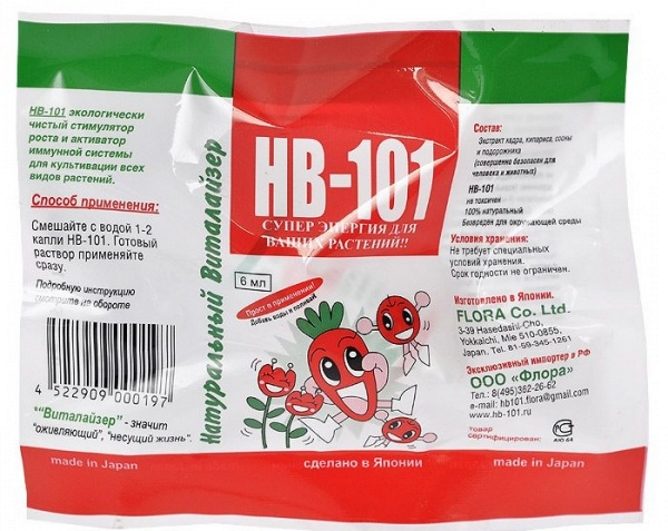

Treatment and prophylaxis scheme with drugs
It is recommended to apply the following scheme of preventive treatment with insecticide preparations:
1. Immediately after flowering, apple trees are sprayed with systemic preparations (Confidor, Antizhuk, Arrivo and others).
2. Re-processing is carried out after 2 weeks.
You can independently prepare a protective solution of laundry soap with carbolic acid... Green soap (2 glasses) and the same amount of carbolic acid are dissolved in a 5-liter container. The mixture is diluted with water to a volume of 20 liters.
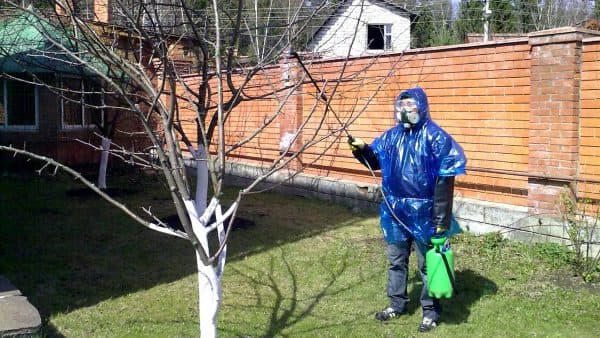

The resulting liquid is sprayed with apple and pear trees.
Clipper - guarding the health of fruit trees
A Russian-made Clipper tool is also suitable for treating trees. Produced in the form of a concentrated emulsion in a 5 liter canister. The drug is based on the active substance bifetrin.
It is used against the bark beetle on fruit trees as an experiment, nevertheless, a positive result has already made itself felt in the process of processing plants in Russian nurseries.
The effect of the remedy lasts for several weeks. The drug can be used in parallel against the typographer bark beetle from the gnawing family, as well as weevils from the sucking group.
An emulsion is prepared that can save the tree, according to the instructions, observing the proportions. The prepared solution is used to spray damaged trees.
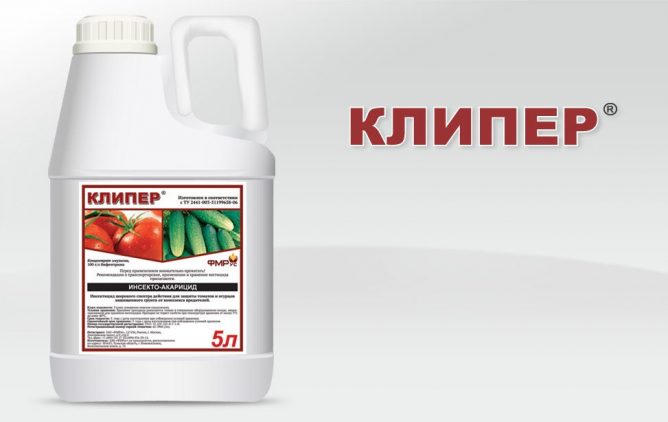

Preventive measures
The main preventive measure for the bark beetle is to keep the orchard clean and tidy:
- regular inspection of fruit plantations;
- timely autumn pruning;
- burning of cut branches;
- removal of plant residues, weeds in the garden.
To protect against the beetle, in the spring, the trunks and skeletal branches are coated with a lime-clay mash (a mixture of clay with manure with the addition of slaked lime). This article will tell you about whitewashing an apple tree in spring.
During the summer of the pest, at some distance from the trees, bait for beetles is laid out in piles - freshly cut branches and hemp. Not later than after 3 weeks - a month of trimming the wood must be burned. Read about pruning old apple trees here.
Remedies for spraying the garden with insecticides
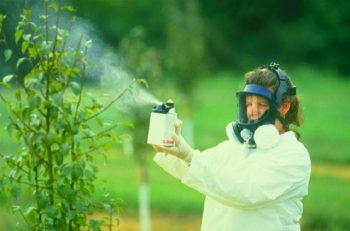

Spraying the garden with pesticides is permissible only in cloudy, calm weather. Gardeners often have to use chemicals, including those with a high hazard class. Therefore, it is advisable to have personal protective equipment in your arsenal:
- respirator;
- mask or goggles;
- special clothing;
- gloves.
It is better to purchase a gas and dust respirator in order to reliably protect against accidental inhalation of both powders when preparing mixtures and aerosols themselves when spraying.
Well proven respirators of the "3M" trademark... Particularly popular is the 3M 9300 series - compact folding models that do not restrict the view and are softly fixed on the face. Another decent option – respirator "Astra-2"... Unlike the 3M models, it has a rigid rubber structure, but it is no less convenient to use and perfectly filters aerosols of any degree of dispersion.
conclusions
- The fight against the bark beetle is quite difficult and requires the use of complex measures: sanitary and hygienic care of plantations, strengthening the immunity of apple trees and pears, preventive spring treatments with systemic drugs.
- A tree that has recently been infected can still be saved by sprinkling the beetle's passages with insecticides. Unfortunately, trees heavily affected by the bark beetle cannot be saved - they have to be destroyed by burning.
- Observing preventive measures, you can prevent infection of the garden. For this, even the little things are important: not to leave open cuts on the trees, protective coating of the trunks with a clay-lime mixture, timely removal of diseased and dried branches. Every gardener is obliged to protect his garden from the insidious invasion of bark beetles.
We help the culture to develop immunity
The best and most effective way to protect trees is to develop immunity in them. It is important to understand that in a healthy culture, the wood will be durable, due to which the bark beetle will bypass such a culture. After all, he is looking for a tree with soft wood, in which it is easier for him to survive and lay off his own offspring.
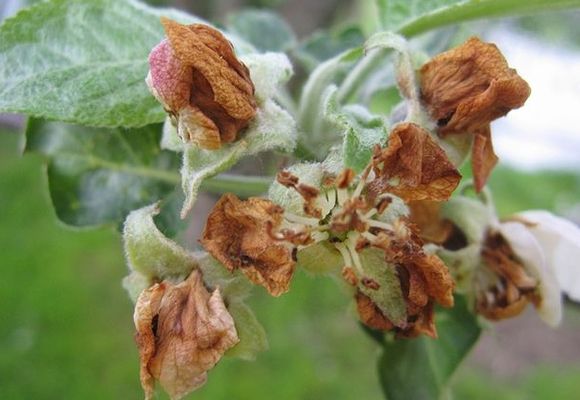

And to raise and strengthen the immune system, use tools such as:
- use the drug HB 10, the granules of which are scattered around the tree, and then watered with water;
- gum 30;
- phosphorus and potash agents.
All these substances are able to strengthen the immune system of the apple culture, and make it unstable to the effects of external negative factors.
What harm do beetles do to fruit trees
In total, scientists know more than 750 species of bark beetles. Of these, almost one and a half hundred species live in Europe. They are smaller - up to a centimeter in length. Exots can exceed 1.5 cm.
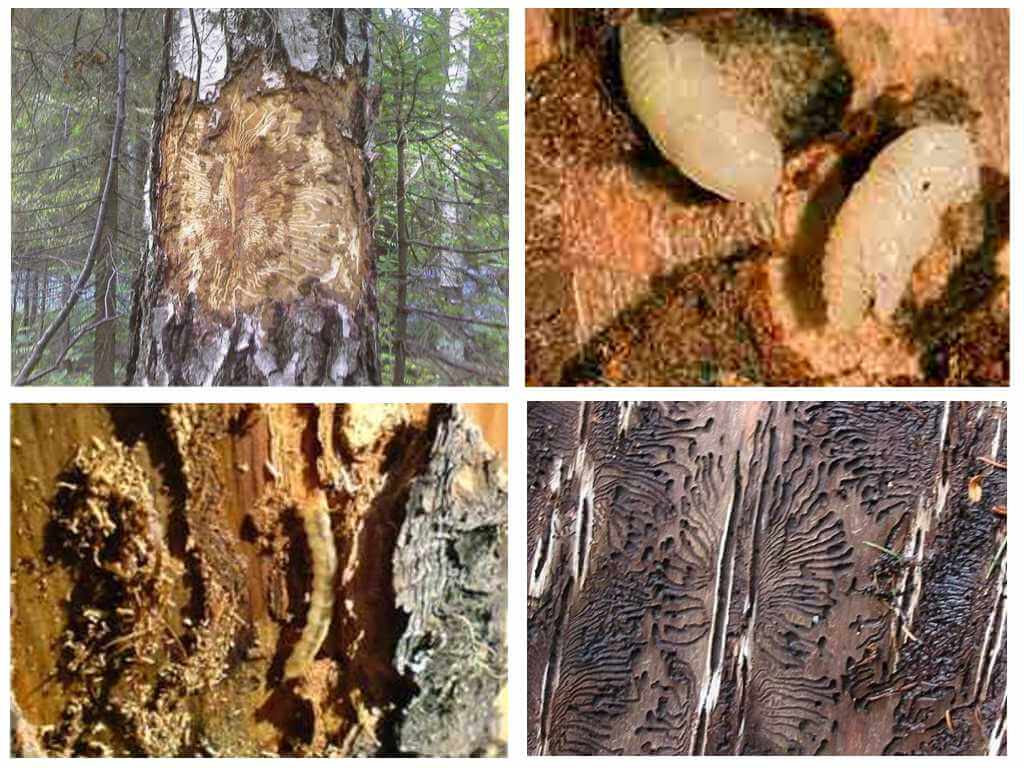

Bark beetle footprints
These insects cause very serious harm to park and garden trees, so the fight against the bark beetle should be serious, complete, especially during outbreaks of the population.
The damage caused by bark beetles to trees is very great. Moreover, the plants are damaged not only by the beetles themselves, but also by the fungus brought by the female. Beetle larvae, damaging the ducts of moisture and nutrients, weaken the plant, while fungi, growing, destroy the tree.
In recent years, a typographer has been increasingly found in our country - a type of bark beetle that has caused enormous damage in most of the regions.

